M1A1 Abrams Main Battle Tank (BAG3)
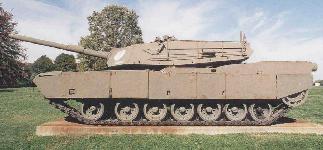
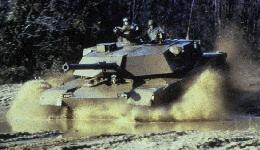
M1A1 Abrams Main Battle Tank
The M1A1 is an improved version of the M1 Main Battle Tank (MBT). It includes a 120mm smoothbore main gun, an NBC overpressure protection system, and an improved armor package. This tank significantly increases the capabilities of the Fleet Marine Forces across the full spectrum of conflict in the near and midterm.
The M1A1 Tank, in addition to the improved armor, 120mm smoothbore gun and the NBC overpressure system, has a Deep Water Fording Kit (DWFK), a Position Location Reporting Systems (PLRS), enhanced ship tiedowns, Digital Electronic Control Unit (DECU) (which allows significant fuel savings),and Battlefield Override.
The M1A1 Tank, in addition to the improved armor, 120mm smoothbore gun and the NBC overpressure system, has a Deep Water Fording Kit (DWFK), a Position Location Reporting Systems (PLRS), enhanced ship tiedowns, Digital Electronic Control Unit (DECU) (which allows significant fuel savings),and Battlefield Override.
The main weapon of the M1A1 is the M256 120mm smoothbore cannon, designed by the Rheinmetall Corporation of Germany. Engagement ranges approaching 4000 meters were successfully demonstrated during Operation Desert Storm. The primary armor-defeating ammunition of this weapon is the armor-piercing, fin-stabilized, discarding sabot (APDS-FS) round, which features a depleted uranium penetrators. Depleted uranium has density two and a half times greater than steel and provides high penetration characteristics. Several other types of ammunition are available as well. It is reliable, deadly accurate and has a "hit/kill ratio" that equals or surpasses any main battle tank armament in the world.
The Driver's night vision equipment enables the tank to maneuver at normal daytime driving speeds in darkness and in poor visibility conditions such as in the dust and smoke encountered on the battlefield.
An improvement program will eventually upgrade all M1A1 tanks with steel encased depleted uranium armor, which has a density at least two-and-a-half times greater than steel. The depleted uranium armor will raise the total weight of the Abrams tank to 65 tons, but offers vastly improved protection in the bargain.
The stowage for the main armament ammunition is in armored ammunition boxes behind sliding armor doors. Armor bulkheads separate the crew compartment from the fuel tanks. The tank is equipped with an automatic Halon fire extinguishing system. This system automatically activates within 2 milliseconds of either a flash or a fire within the various compartments of the vehicle. The top panels of the tank are designed to blow outwards in the event of penetration by a HEAT projectile.
Nuclear, Biological and Chemical (NBC) warfare protection is provided by an overpressure clean-air conditioning air system, a radiological warning system, and a chemical agent detector. The crew are individually equipped with protective suits and masks.
The Marine Corps has fielded the M1A1 Common Tank to replace the aging M60A1 Rise/Passive tank.
The M60 has reached the end of its service life and lacks the capability to survive and to defeat the threats expected to be encountered on the modern battlefield. During Operation Desert Shield/Storm, the Marine Corps borrowed 60 M1A1s (called the M1A1 Heavy Armor) from the US Army. There were also 16 Marine Corps M1A1 Tanks delivered on an accelerated schedule for employment during the operation. This total of 76 M1A1 tanks was employed by 2d Tank Battalion and elements of 4th Tank Battalion. The M1A1 tanks saw immediate action during the I Marine Expeditionary Force (IMEF) drive through the burning Kuwaiti oil fields. All loaned tanks were returned to the US Army after Desert Storm.
The M60 has reached the end of its service life and lacks the capability to survive and to defeat the threats expected to be encountered on the modern battlefield. During Operation Desert Shield/Storm, the Marine Corps borrowed 60 M1A1s (called the M1A1 Heavy Armor) from the US Army. There were also 16 Marine Corps M1A1 Tanks delivered on an accelerated schedule for employment during the operation. This total of 76 M1A1 tanks was employed by 2d Tank Battalion and elements of 4th Tank Battalion. The M1A1 tanks saw immediate action during the I Marine Expeditionary Force (IMEF) drive through the burning Kuwaiti oil fields. All loaned tanks were returned to the US Army after Desert Storm.
Due to unique Marine Corps amphibious requirements, and the need for both supportability and interoperability between the Marine Corps and the US Army, the two services agreed to jointly produce the M1A1 Main Battle Tank. The M1A1 MBT has the capability to conduct operations ashore. It is compatible with all US Navy amphibious ships and craft (to include the LCAC) and Maritime Prepositioning Ships (MPS). The USMC completed fielding of all tanks, to include active, reserve, MPS, and depot maintenance float (DMF) during FY 96.
In 1995 the 26th MEU became the first amphibiously deployed unit to carry the M1A1. This added some complication to the logistics of the unit due to the tank's weight. Topping the scales at over 68 tons the vehicle requires special care during amphibious operations. One tank can be carried at a time on an Air Cushioned Landing Craft (LCAC), two on a Landing Craft Utility (LCU), but only during fairly calm seas. For operations with the Marine Corps, tanks have been equipped with special fording systems. These modifications include extended air intake and exhaust tubes that allow the vehicles to cross rivers and shallow waters such as the surf zones that Marines operate in.
M1A1D Abrams Main Battle Tank
In the survivability area the Army is working to develop and field a contingency armor package that is thin and lightweight, but with a high level of protection. These armor packages can be applied to either the side or front of Abrams tanks to provide additional protection as required by the mission. The Army is also seeking to fundo resource upgrades to the M1A1 fire control system with the same 2nd Gen FLIR package on the M1A2.
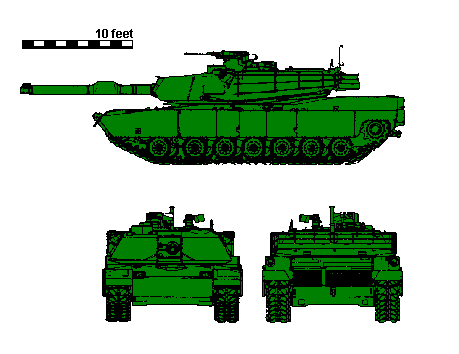
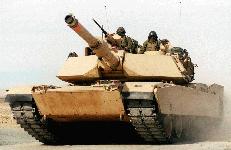
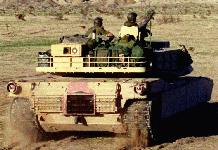


0 komentar
Write Down Your Responses